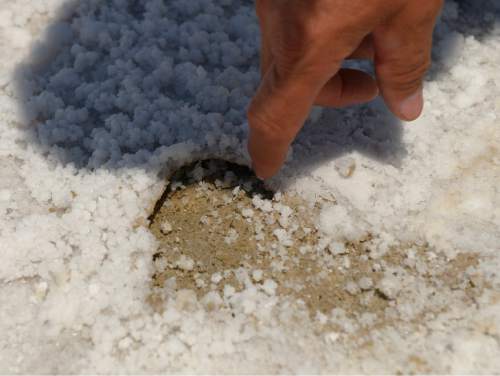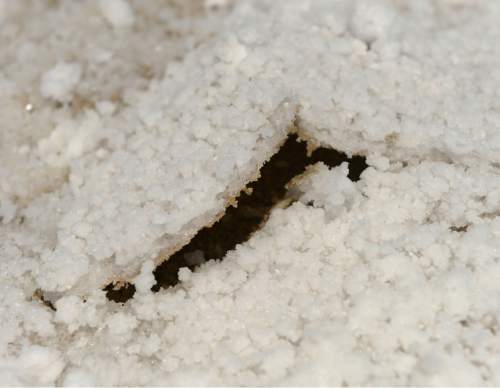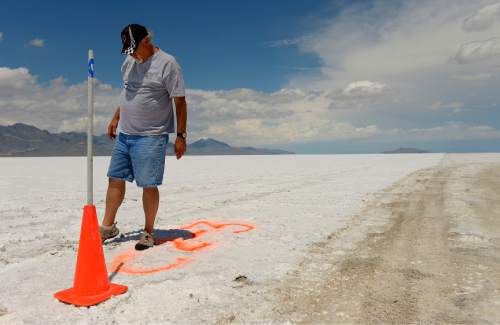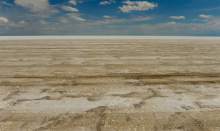This is an archived article that was published on sltrib.com in 2016, and information in the article may be outdated. It is provided only for personal research purposes and may not be reprinted.
Preliminary data suggest the size and quality of the Bonneville Salt Flats have declined over the past 30 years, but researchers say it's not clear why those changes have occurred, and they caution that taking action without understanding the salt flats' system could cause further damage.
Satellite imagery analyzed by University of Utah researchers demonstrates a decadeslong trend of decline that has no clear correlation with other factors like mining activity or the weather, according to Brenda Bowen, the geologist leading the study.
What is clear, Bowen told a group of stakeholders Tuesday, is that the Bonneville Salt Flats is a complex, dynamic geological system.
The all-day gathering to discuss the state of the Utah landmark and the science behind it was hosted by the Bureau of Land Management, which had invited representatives from the international land-speed racing community, local governments and Intrepid Potash, which operates near the flats.
"On geologic time scales, this part of the world is changing rapidly," a result of a combination of natural and anthropogenic — human-caused — forces, Bowen said.
And though salt flats in general can be permanent features of a landscape if the system that created them doesn't change, she said, they can also be ephemeral, disappearing and reforming based on geologic conditions.
Promises to continue studying the Bonneville Salt Flats and determine what is causing its decline didn't satisfy the land-speed racers, who rely on the flats' crust to help their cars achieve speeds in excess of 300 or even 400 miles per hour.
They continue to campaign for additional salt to be pumped onto the salt flats — the sooner the better. It's been too long since the BLM was willing to take any action to mitigate the salt flats' decline, they said, and waiting for the U. to finish studying the flats — a final report is not due until 2018 — is unacceptable.
If the BLM does not produce some tangible movement soon, one racer predicted, it would mean "war" between the two.
But determining how to reverse the decline is difficult, said Bowen — especially given that it's unclear what's causing the flats to decline or even how they form.
While the Great Salt Lake is a direct remnant of the prehistoric Lake Bonneville, the salt flats are an offshoot, created when saltwater from the Great Salt Lake overflowed into the West Desert. Geologic evidence suggests that massive flooding has occurred at least twice in the past 3,000 years, Bowen said, but the system has changed in ways that may make this less likely to occur in the future.
And despite the role the Great Salt Lake played in the flats' development, it's not a magic bullet, Bowen added. During the late 1980s, water from the Great Salt Lake was pumped into the West Desert to prevent flooding. But though that added an estimated 386 tons of salt to the flats, the decline persisted, Bowen said.
Since 1998, Intrepid Potash, a mining company that extracts potassium from the brine beneath the salt flats, has pumped more than 5 million tons of salt brine onto the salt flats as a part of an experimental salt laydown study. And though initial scientific models expected the project to add 2 inches of salt to the crust, subsequent studies could find no change in its depth.
There has been no study of the salt crust's thickness since 2003, Bowen said.
Dennis Sullivan, chairman for the Utah Alliance to Save the Salt, said the racing community would like to see Intrepid Potash return to pumping upwards of 1 million tons of salt onto the flats each year, as in the early days of the salt laydown project.
Eric Rogers, a plant manager for Intrepid Potash, said he didn't believe that was possible. Intrepid is limited by the amount of water it can pump from its wells, he said.
Rogers — stressing that his views were his own and could not represent those of the company, which had not known that the meeting would be open to the public or media — said he felt it was unwise to change the laydown program in the absence of a better understanding of the salt flats' system.
"We don't know what the cause of the thinning is," he said. "We don't have an understanding of how it works, how it's changed, and what causes those changes."
And the brine pumped onto the salt flats for the laydown project could actually dissolve the hard surface used by the racers, he said.
Those representing the racing community held that additional salt laydown — at least enough to replace what has been removed from the salt flats as a consequence of mining — was the simplest and most important solution.
"It's common sense," Sullivan said. "If we dig a hole here and put the dirt over there, I know where the hole came from, and if I put the dirt back, then we're back to square one."
The group also discussed the possibility of limiting public access to the flats during the off season to prevent damage to the flats.
An additional option floated during the meeting — to wait for the completion of the U. study before taking action — failed to gain much traction with the racers, who said they feared there would be nothing left of the salt flats but mud by the time the study is completed in 2018.
Wendover City Mayor Mike Crawford called out the racers for that rhetoric, saying it has led some of the area's regular tourists to conclude that they will never again visit Wendover.
That simply isn't true, Crawford said. This year so far is shaping up to be a good year for salt, so long as this summer is hot enough to evaporate the water currently sitting on the flats.
The U., with funding from Intrepid Potash and national science grants, plans to begin collecting new core samples of the salt flats' sedimentary layers this fall, weather permitting.
Twitter: @EmaPen









